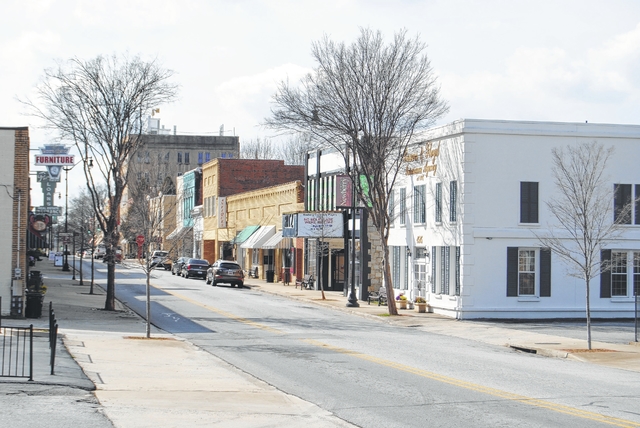NEWBERRY — In 2014 Newberry City Council began the Downtown Facade Improvement Grant Program, the aim of which was to help beautify downtown and attract more businesses.
The purpose of the program is to promote storefront rehabilitation in Newberry’s Historic Downtown area, preserve the unique character of downtown’s historic buildings, encourage aesthetic compatibility for improvements to facades of non-historic structures, and encourage the use of quality materials in the rehabilitation of downtown properties.
The city has made a series of improvements downtown since the Newberry Opera House reopened, Mayor Foster Senn said.
“One of the first efforts was to remove asphalt to uncover some old brick streets. We have had beautification projects with new trees and flowers, and we have put up new signs, for example. All that has come together nicely,” Senn said. “The facade program addresses one of the most important parts of downtown, the businesses. We want our small businesses and people downtown to be successful.”
One challenge for small businesses is capital, he said.
“The facade grants give them the opportunity to improve their storefronts. It has been very successful and improved the looks of those storefronts, and thus improved our downtown,” Senn said.
Ward Braswell, director of planning and development services, said qualifying projects are eligible for a grant match of 90 percent on projects up to $10,000 per facade, or $9,000 on a $10,000 project. So typically the applicants will only pay 10 percent for the project, unless it is over $10,000.
However, projects proposals are not capped at $10,000. Applicants are encouraged to strongly leverage their grant funds to get the most from their investment.
To be eligible for this program, a business or commercial property (which must be classified as business/commercial) must be located on Main Street or within the Newberry Historic District. Tenants are able to apply, but they must include the owner’s written permission.
Applicants are only eligible for one grant per year, as funds are limited. A property may be eligible for an additional grant if at least three years have elapsed since the last grant was awarded and the property is in need of further improvement.
Under extenuating circumstances an additional grant may be awarded prior to the three years from the last grant, if deemed necessary by the City of Newberry’s Architectural Review Board. They may also be eligible if the existing business or property undergoes significant expansion which requires improvement to the property.
There must also not be any delinquent bills, business license, charges or taxes due to the city of Newberry.
Applicants have to keep some design guidelines in mind:
• Improvements should contribute to the pedestrian environment by enhancing the aesthetic impact of the facade by adding visual interest to the streetscape.
• Improvements should provide a year round impact. Improvements should be completed in ways that are compatible with the original design of the structure.
• Improvements should not shield form public view nor cause the removal of architecturally significant features.
• Improvements should contribute to the building’s character.
• Improvements should encourage other restoration or redevelopment within the downtown area.
Improvements can include facade improvements, brick or wall surface cleaning, patching and painting of facade walls, signage of exterior lighting replacement/repair (only established businesses, three plus years, are eligible for sign replacement), structure or frame that contains or holds a sign, canopy, porch, awning installation/repair, window and or door replacement/repair, mortar joint repair, railings, ironwork repair or addition, cornice repair and or replacement.
Ineligible improvements include, but are not limited to, building maintenance including paint to match existing conditions and differed general repairs; parking lot improvements; interior or roof improvements; removal of architecturally significant building features; purchase property, inventory or operating capital; any activity completed prior to receiving grant funds.
Braswell added that applications must have a minimum of two qualified and professional estimates of cost. Applications will be presented and reviewed by the Architectural Review Board, at which point they will give approval of the colors and changes to the building. Once the projects are approved, the applicant has six months to finish the project.
The first year, fiscal year 2014, the city received about 19 applicants, and $100,000 was budgeted for the program. The following year they had 17 applicants, with $150,000 budgeted. This past year they had six applicants, but only $50,000 budgeted.
“Everyone who has applied, except for one, has been approved,” Braswell said.
Since the beginning of this program four years ago there have been a multitude of renovations made downtown. Some examples include the rejuvenated Coca-Cola mural, the Grille on Main added awnings and took off paint and show exposed brick and the Main Street Bakery (now closed) did work on the front of their building.
Projects from this past year include awnings at the new Literacy Council location, Grille on Main is re-doing their doors and the Ritz is putting up vitrolite (an opaque pigmented glass).
“I think the impact of the City’s facade grant program has had on Downtown is evident in the aesthetic improvements that have been made over the last several years. I often hear from folks that downtown Newberry has never looked better, and it is easier work when the business owners and the City can work together to make Downtown Newberry an even more appealing place to come shop, dine, and be entertained,” said Matt DeWitt, Newberry City Manager
The 2017 Facade Grant applications will probably start being made available in May, and then they would be due in July. However, that is not definite and could change.

